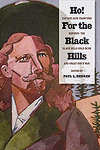 Ho! For the Black Hills: Captain Jack Crawford Reports the Black Hills Gold Rush and Great Sioux War, edited by Paul L. Hedren, South Dakota State Historical Society Press, Pierre, 2012, $29.95
Ho! For the Black Hills: Captain Jack Crawford Reports the Black Hills Gold Rush and Great Sioux War, edited by Paul L. Hedren, South Dakota State Historical Society Press, Pierre, 2012, $29.95
This trove of words compiled by award-winning Western historian Paul L. Hedren features the letters written by Captain Jack Crawford, self-proclaimed “Poet Scout of the Black Hills,” when he was a correspondent for the Omaha (Neb.) Daily Bee during the 1874–77 Black Hills Gold Rush. John Wallace Crawford loved gold as much as the next man, but he also felt he must deliver solid, rich copy to his editor. Some of his letters went to other newspapers, including The Black Hills Pioneer and The New York Herald, and he also wrote about the Sioux War of 1876 while accompanying Brig. Gen. George Crook in the Starvation March and the Battle of Slim Buttes in Dakota Territory. His letters are loaded with particulars about the gold rush and war. As he put it in a July 13, 1876, letter that ran in the Pioneer, “I tried to tell the people facts, and no one but tenderfeet and weak-kneed pilgrims ever contradicted me; and now I can say, after all these roosters have left the country, there are 5,000 as brave men as ever banded together in any country, in the Black Hills today.”
Although he was a genuine Army scout and showman with a catchy nickname, just like Buffalo Bill Cody, Captain Jack Crawford is almost forgotten today. Darlis A. Miller’s 1993 biography Captain Jack Crawford: Buckskin Poet, Scout and Showman introduced Jack to many people, and this collection should make him a bigger name, at least among those who care about the Wild West. Authors have offered up various military and honorific reasons for Crawford’s using “Captain” for the first time in October 1877, but Hedren says the title was the result of the man honing his “self-image and the budding of a public persona, instilled by exposure to men like Buffalo Bill, Texas Jack, Wild Bill and California Joe and others…like Crook.” At the same time Crawford began to dress the part of a dapper frontiersman in the mold of Buffalo Bill Cody and Wild Bill Hickok.
Hedren provides plenty of useful background about Crawford, the invasion of the Black Hills and the Sioux War while presenting the letters in the order Captain Jack wrote them. Most interesting is the relationship between Captain Jack and Buffalo Bill. Cody took a “first scalp for Custer” at Warbonnet Creek in Nebraska, while Crawford apparently took a scalp at Slim Buttes for his friends in Omaha. Captain Jack, on Cody’s invitation, joined the touring Buffalo Bill Combination. But as Hedren tells us, “Matters of Crawford’s compensation and a shooting incident in Virginia City, Nev., strained and then shattered this unique relationship.”
Naturally, the scout-poet sprinkled some letters with poetry. In one verse he gives advice about fighting the Sioux:
And fight ye will with heart and hand,
I know your feelings well;
But not in solid mass to stand
Before these fiends of h_ll
A rock is good enough for you,
Or shelter of a tree,
To fight this brave and noble Sioux,
And that’s the style for me.
—Editor




